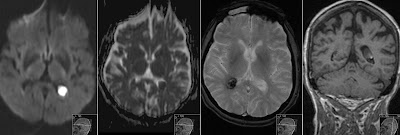CSF Leakage Spine - MRI Protocol
I have already mentioned CSF Leakage - Intracranial Hypotension and Intracranial Hypotension before. Here I would like to present a simple and effective MRI protocol to show the CSF leakage. The clue is to use heavy T2 weighted sequence with thin slice, good resolution and what is most important - fat saturation. We want to get rid of epidural fat. Note on the images above the epidural CSF dorsally to dural sack that extends from cervical to low thoracic level. Sagittal projections show extend of the leakage, while tranversal images show more detail anatomy. This investigation was performed on Siemens Trio Tim 3T machine with the same sequence in two projections:
- sag: t2_spc_sag_p3_iso_384_myelo
Nex 2
Slice 0.8 mm
TR: 1500
TE: 224
Flip angle: 110
- tra: t2_spc_tra_p2_iso_320_myelo
Nex 2
Slice 1 mm
TR: 1500
TE: 224
Flip angle: 110
For the location of the tranversal sections it is wise to ask your technicians to request radiologist supervision. It is also useful to make coronal reconstructions from the sagittal sequences as well as rotating MIP reconstructions. The exact place of leakage is often difficult to visualize.
Above images of the brain from the the same patient showing fresh bilateral subdural hematomas and sagging of the midbrain. Note the low position of mesencephalon and pituitary stalk.




